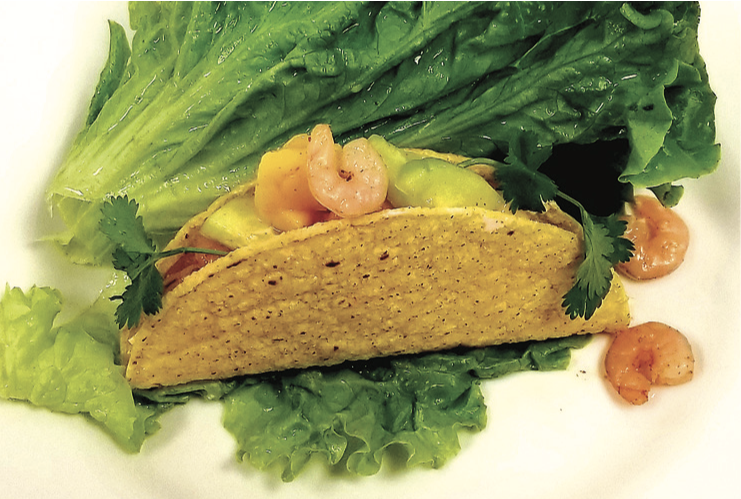Shrimp Tacos with Ginger and Mango Salsa

Makes 6 servings | Serving size: 1 taco
Ingredients for Shrimp:
- 4 tablespoons smoked paprika
- 1 tablespoon oregano
- 1 teaspoon chipotle chili powder
- ½ teaspoon garlic powder
- ¼ teaspoon cayenne red pepper
- 1/4 teaspoon dry mustard
- 1 tablespoon olive oil
- 1 pound medium shrimp, deveined
Ingredients for Ginger Mango Salsa:
- 1 medium mango, diced
- ½ medium cucumber, diced
- ¼ teaspoon fresh ginger, minced
- ½ teaspoon chili powder
- 1 tablespoon cilantro, minced
Other Ingredients
- 6 corn tortillas (can also use whole wheat tortilla or lettuce leaves to make a wrap)
Directions:
- In a medium bowl, mix paprika, oregano, chipotle chili powder, garlic powder, red pepper, and dry mustard.
- Add raw shrimp. Coat thoroughly.
In a small bowl, combine ingredients for salsa. Cover and chill. - In a large skillet, heat olive oil over medium heat.
- Add shrimp and cook until pink (Fish should be cooked to an internal temperature of 145°F and will flake easily when it is thoroughly cooked.)
- Divide shrimp between 6 tacos (or wraps). Top with salsa.
Nutrition Information Per Serving: 178 Calories, Total Fat 5g, Saturated Fat 1g, Protein 13g, Total Carbohydrate 23g Dietary Fiber 4.5g, Sodium 465mg. Excellent source of vitamins A and C. Good source of iron.
Recipe contributed by Kathy Copeland and Della Hicks, NC EFNEP Educators
Colorful Coleslaw
Makes 8 servings Serving Size: 1/2 cup
Ingredients
- 2 cups shredded green cabbage
- 1 cup shredded red cabbage
- 1/4 cup thinly sliced onion
- 1 medium carrot, grated
- 1/2 cup finely chopped bell pepper
Dressing Ingredients
- 2 tablespoons honey
- 1 1⁄2 tablespoons vegetable oil
- 1 1⁄2 tablespoons vinegar
- Pinch of salt
- 1/2 teaspoon black pepper
Directions
1. Make dressing first. In a large bowl mix together the honey, oil, vinegar, salt, and black pepper.
2. Add cabbage, onion, carrot, and bell pepper to bowl.
3. Toss to coat all ingredients with dressing.
4. Cover and refrigerate for 1–2 hours before serving.
Nutrition Information Per Serving
55 Calories, Total Fat 2.5g, Saturated Fat 0g, Protein 1g, Total Carbohydrate 7g, Dietary Fiber 1g, Sodium 55mg. Excellent source of vitamins A and C.
Fruit Poppers
Ingredients
• 3 cups whole strawberries
• 1 (5.3-ounce) container nonfat vanilla flavored Greek yogurt
• 1 teaspoon orange juice
• ½ teaspoon ground cinnamon
• 4 whole wheat honey graham crackers
• 14 pieces dark chocolate chips
Directions
1. Line a sheet pan with wax paper.
2. Wash berries. Pat dry.
3. With a paring knife, remove stems. Cut “X” in strawberry at the stem, continuing cut to midpoint of berry.
4. In a small bowl, mix yogurt, orange juice, and cinnamon together. Place in resealable bag.
5. In another resealable bag, crush graham crackers until very fine. Move to small saucer.
6. Place chocolate chips in a small microwave safe bowl and heat on high for 10 seconds. Stir. Repeat until chocolate is melted.
7. On counter, line up ingredients in this order: prepared strawberries, yogurt mix, chocolate, graham crackers, and prepared pan.
8. Cut a small hole on one end of plastic bag with yogurt to form a piping bag.
9. Fill strawberry with yogurt, dip in chocolate, roll in graham cracker crumbs and place on prepared pan.
Repeat until all strawberries are prepared.
10. Place in freezer for 20 minutes or until yogurt and chocolate are firmly set.
Recipe contributed by Nicole Simmons, Former NC EFNEP Educator
Dessert Hummus
Ingredients:
- 1 (14.5-oz.) can great northern beans, drained and rinsed
- 1⁄4 c. creamy peanut butter
- 1⁄4 c. maple syrup
- 1⁄4 Tbsp. vanilla extract
- 1⁄4 c. mini semisweet chocolate chips
Instructions:
Blend together the beans, peanut butter, maple syrup and vanilla extract by hand or in a blender. Stir chocolate chips into mixture. Serve with fruit or graham crackers.
Yield: 6 servings
Recipe from: North Dakota State University EFNEP
Pumpkin Breakfast Cookies
Ingredients
- 1 ¾ cups cooked, pureed pumpkin (15 ounce can)
- 1 cup packed brown sugar
- 2 eggs
- ½ cup vegetable oil
- 1 cup of old fashioned oats
- ¾ cups all purpose flour
- 1 cup whole-wheat flour
- 1 Tablespoon baking powder
- 2 teaspoons cinnamon
- 1 teaspoon nutmeg
- ½ teaspoon salt
- ¼ teaspoon ground ginger
- 1 cup raisins
- 1 cup walnuts or hazelnuts, chopped
Directions
- Wash hands with soap and water.
- Preheat oven to 400˚ F.
- In a large bowl, stir together pumpkin, brown sugar, eggs and oil. Mix well until smooth.
- In another bowl, stir together the flours, baking powder, cinnamon, nutmeg, ginger and salt. Add to the pumpkin mixture and mix well.
- Stir in raisins and nuts.
- Drop the dough by a tablespoon on to a greased baking sheet, 1 inch apart.
- Gently flatten each cookie with the back of a spoon.
- Bake 10 to 12 minutes until tops are dry and begin to brown.
Original recipe from Food Hero